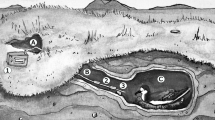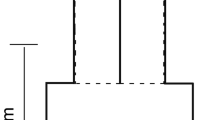Abstract
Among procellariiform seabirds, many burrowing petrels show good olfactory abilities especially in recognising their nest. In particular, it has been reported that Antarctic prions (Pachyptila desolata) discriminate their own and their mate’s odours and, in Y-maze experiments, prefer the odour of a conspecific bird to their own. While traditionally examined from the perspective of homing mechanisms, these recent results have drawn attention to the possible use of chemical signals in birds’ social behaviours. Indeed, the life history of petrels suggests that a mate choice mediated by olfactory mechanisms may have evolved in this group to ensure genetic compatibility. This study was undertaken to validate and extend results obtained on petrels’ olfactory discrimination capabilities. Following the Y-maze experiment protocol, blue petrels (Halobaena caerulea) were offered three different choices: (1) mate versus conspecific’s odour, (2) own versus mate’s odour and (3) own versus conspecific’s odour. We discovered that birds prefer the odour of their mate not only when presented against conspecific’s odour but also against their own. We further verified that blue petrels also avoid their own odour when presented against conspecific’s odour. Our results confirm that olfactory discrimination in burrowing petrels goes beyond self-recognition and that self-odour avoidance may be widespread. We use two mutually non-exclusive behavioural frameworks for the interpretation of our results, homing and mate choice, and explain why homing mechanisms cannot account for all of our observations. This study opens the door to further research on olfactory mechanisms that, in petrels, might mediate individual recognition and mate choice.

Similar content being viewed by others
References
Aubin T, Jouventin P, Hildebrand C (2000) Penguins use the two-voice system to recognize each other. Proc R Soc Lond B Biol Sci 267:1081–1087
Bang BG (1966) The olfactory apparatus of tubenosed birds (Procellariiformes). Acta Anat 65:391–415
Blomqvist D, Andersson M, Kupper C, Cuthill IC, Kis J, Lanctot RB, Sandercock BK, Szekely T, Wallander J, Kempenaers B (2002) Genetic similarity between mates and extra-pair parentage in three species of shorebirds. Nature 419:613–615
Bonadonna F (2008) Olfaction in petrels: from homing to self-odor avoidance. Ann NY Acad Sci (in press)
Bonadonna F, Nevitt GA (2004) Partner-specific odor recognition in an Antarctic seabird. Science 306:835
Bonadonna F, Cunningham GB, Jouventin P, Hesters F, Nevitt GA (2003a) Evidence for nest-odour recognition in two species of diving petrel. J Exp Biol 206:3719–3722
Bonadonna F, Hesters F, Jouventin P (2003b) Scent of a nest: discrimination of own-nest odours in Antarctic prions, Pachyptila desolata. Behav Ecol Sociobiol 54:174–178
Bonadonna F, Villafane M, Bajzak C, Jouventin P (2004) Recognition of burrow’s “olfactory signature” in blue petrels, Halobaena caerulea: an efficient discrimination mechanism in the dark. Anim Behav 67:893–898
Bonadonna F, Miguel E, Grosbois V, Jouventin P, Bessiere J-M (2007) Individual odor recognition in birds: an endogenous olfactory signature on petrels’ feathers? J Chem Ecol 33:1819–1829
Bonneaud C, Chastel O, Federici P, Westerdahl H, Sorci G (2006) Complex MHC-based mate choice in a wild passerine. Proc R Soc B Biol Sci 273:1111–1116
Bretagnolle V (1989) Calls of Wilson's storm petrel: functions, individual and sexual recognitions, and geographic variation. Behaviour 111:98–112
Bried J, Jouventin P (2002) Site and mate-choice in seabirds: an evolutionary approach. In: Schreiber EA, Burger J (eds) Biology of marine birds. CRC, Boca, pp 263–305
Brown JL, Eklund A (1994) Kin recognition and the major histocompatibility complex—an integrative review. Am Nat 143:435–461
Dawkins R (1982) The extended phenotype. Freeman, San Francisco, CA
De Leon A, Minguez E, Belliure B (2003) Self-odour recognition in European storm-petrel chicks. Behaviour 140:925–933
Fenoglio S, Cucco M, Fracchia L, Martinotti MG, Malacarne G (2004) Shield colours of the Moorhen are differently related to bacterial presence and health parameters. Ethol Ecol Evol 16:171–180
Galeotti P, Saino N, Sacchia R, MØller AP (1997) Song correlates with social context, testosterone and body condition in male barn swallows. Anim Behav 53:687–700
Genevois F, Bretagnolle V (1994) Male blue petrels reveal their body weight when calling. Ethol Ecol Evol 6:377–383
Grubb TC (1974) Olfactory navigation to the nesting burrow in Leach’s petrel (Oceanodroma leucorrhoa). Anim Behav 22:192–202
Hauber ME, Sherman PW, Paprika D (2000) Self-referent phenotype matching in a brood parasite: the armpit effect in brown-headed cowbirds (Molothrus ater). Anim Cogn 3:133–117
Heth G, Todrank J, Johnston RE (1998) Kin recognition in golden hamsters: evidence for phenotype matching. Anim Behav 56:409–417
Johnsen A, Andersen V, Sunding C, Lifjeld JT (2000) Female bluethroats enhance offspring immunocompetence through extra-pair copulations. Nature 406:296–299
Jouventin P, Mouret V, Bonadonna F (2007) Wilson’s storm petrels Oceanites oceanicus recognise the olfactory signature of their mate. Ethology 113:1228–1232
Mateo JM, Johnston RE (2000) Kin recognition and the ‘armpit effect’: evidence of self-referent phenotype matching. Proc R Soc Lond B 267:695–700
Maynard Smith J, Harper D (2003) Animal signals. Oxford University Press, Oxford
Minguez E (1997) Olfactory recognition by British storm-petrel chicks. Anim Behav 53:701–707
Mougeot F, Bretagnolle V (2000a) Predation as a cost of sexual communication in nocturnal seabirds: an experimental approach using acoustic signals. Anim Behav 60:647–656
Mougeot F, Bretagnolle V (2000b) Predation risk and moonlight avoidance in nocturnal seabirds. J Avian Biol 31:376–387
Nevitt GA, Bonadonna F (2005) Seeing the world trough the nose of a bird: new developments in the sensory ecology of procellariiform seabirds. Mar Ecol Prog Ser 287:292–295
Nicolaus M, Bohec CL, Nolan PM, Gauthier-Clerc M, Maho YL, Komdeur J, Jouventin P (2007) Ornamental colors reveal age in the king penguin. Polar Biol 31:53–61
Nolan PM, Jouventin P, Dobson FS (2004) Plumage color predicts immune response in king penguins. Integr Comp Biol 44:612–612
Olsson M, Madsen T, Nordby J, Wapstra E, Ujvari B, Wittsell H (2003) Major histocompatibility complex and mate choice in sand lizards. Proc R Soc B Biol Sci 270(Suppl):S254–S256
Penn D (2002) The scent of genetic compatibility: sexual selection and the major histocompatibility complex. Ethology 108:1–21
Pryke SR, Griffith SC (2006) Red dominates black: agonistic signalling among head morphs in the colour polymorphic Gouldian finch. Proc R Soc B Biol Sci 273:949–957
Roper TJ (1999) Olfaction in birds. Adv Study Behav 28:247–332
Singh PB (2001) Chemosensation and genetic individuality. Reproduction 121:529–539
Tregenza T, Wedell N (2000) Genetic compatibility, mate choice and patterns of parentage: invited review. Mol Ecol 9:1013–1027
Warham J (1996) The behaviour, population biology and physiology of the petrels. Academic, London
Wyatt TD (2003) Pheromones and animal behaviour. Cambridge University Press, Cambridge
Yamazaki K, Beauchamp GK (2005) Chemosensory recognition of olfactory individuality. Chem Senses 30:142–143
Zelano B, Edwards VE (2002) An MHC component to kin recognition and mate choice in birds: predictions, progress, and prospects. Am Nat 160:225–238
Acknowledgements
This work was supported by the Institut Polaire Français Paul-Emile Victor (IPEV, Program no. 354). This study was performed according to guidelines established by IPEV and CNRS for the Ethical Treatment of Animals and complied with current French regulations. We thank Dr. Sandra Saunders and two reviewers for their criticism of earlier drafts of the manuscript. Giulia Giaconi (the grand mother of FB) graciously sewed the cotton bags.
Author information
Authors and Affiliations
Corresponding author
Additional information
Communicated by K. Lindström
Rights and permissions
About this article
Cite this article
Mardon, J., Bonadonna, F. Atypical homing or self-odour avoidance? Blue petrels (Halobaena caerulea) are attracted to their mate’s odour but avoid their own. Behav Ecol Sociobiol 63, 537–542 (2009). https://doi.org/10.1007/s00265-008-0688-z
Received:
Revised:
Accepted:
Published:
Issue Date:
DOI: https://doi.org/10.1007/s00265-008-0688-z




